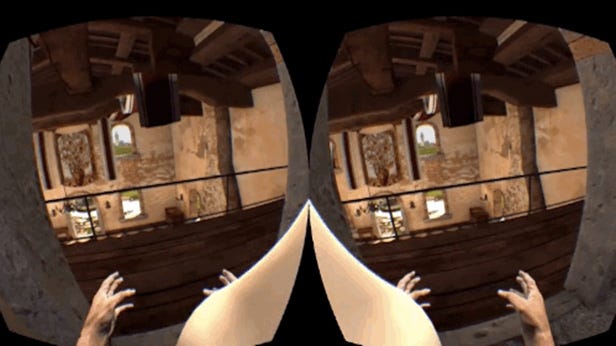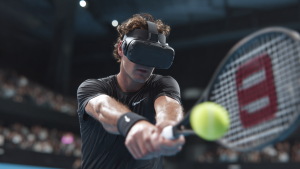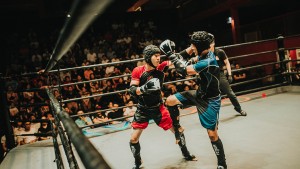VR Sickness: HOW to measure & prevent it
Virtual Reality | April 11, 2015
As explained in part I VR Sickness: WHAT & WHY, Virtual Reality (VR) Sickness, as proposed by Jason Jerald in The VR Book, is an all encompassing term for motion, cyber- and simulation sicknesses caused during playing around in VR. Now, in part II let’s consider how to prevent it, using tricks based on previously presented theory.
… This is part II of VR Sickness topic. I recommend reading part I: VR Sickness: WHAT & WHY first to catch up on definitions and theories, since they are used as basis for this article…
Using virtual nose as rest frame, source: trustedreviews.com
Doctor, how bad is it?…- how to measure?
VR Sickness is an elusive phenomenon. It is not easy to measure it and even more difficult to predict it. There are 3 key challenges if you want to measure it in your experience:
- there is a huge variance between individuals, which means it’s hard to notice any pattern,
- same user may react differently every time he uses VR, for example because he/she adopts to using VR,
- and if you want to make any valid conclusions out of your measurements, you need a considerable amount of people you tested it on, so that you account for high variance between users and habituation of single users.
Now, there are 2 very well standardized methods to measure severity of VR Sickness. First, lets talk about one of the more convincing questionnaires I have ever seenÌ¢âÂÊ—Ì¢âÂÊand believe me, I had seen my share…
“I” feel sick!Ì¢âÂÊ—Ì¢âÂÊsubjective measurements
The Kennedy Simulator Sickness Questionnaire (SSQ), published in 1993, was tested on more than 1000 users in 10 different flight simulators! For scientific standards this is… a Utopian Dream. Anyhow, as a result of study using this questionnaire, 16 symptoms were identified. They clustered into 3 categories:
- oculomotor,
- disorientation,
- nausea.
In the end, by using SSQ we can know exact total severity of VR sickness and the level of other 3 clusters of symptoms. Easy, right? Don’t forget to give this questionnaire to your users only AFTER the experience, since reading about symptoms my actually induce them! (Kennedy et. al, 1993).
“You” look sickÌ¢âÂÊ—Ì¢âÂÊbehavioral measurements
An easier and less cumbersome measurement of motion sickness is a behavioral test called Sharpened Romberg Stance. Have you even been stopped by police while driving a car, and asked to walk a straight line, so that Man in Blue can check if you are sober or not? Well, this test is pretty much that. The task is to put one foot in front of the other with heel touching toe, weight evenly distributed between the legs, arms folded across the chest, chin up. The number of times a user breaks the stance is the postural instability measure. In other wordsÌ¢âÂÊ—Ì¢âÂÊthe harder it is to keep balance, the worse VR sickness effects are.
<——- Sharpened Romberg Stance, source: Ossama M. (2013)
I don’t want to get sick!Ì¢âÂÊ—Ì¢âÂÊhow to prevent
First, some facts (provided by my beloved VR encyclopediaÌ¢âÂÊ—Ì¢âÂÊThe VR Book):
- as mentioned before, the more experience you are with VR, the less likely you will get VR sickness,
- reading, talking or thinking right before or during the VR experience about VR sickness symptoms may actually induce themÌ¢âÂÊ—Ì¢âÂÊit’s called priming,
- did you know that woman are 3x more likely to get motion sick then man?
- real world experience with task creates expectations towards HOW IT SUPPOSED TO WORKÌ¢âÂÊ—Ì¢âÂÊif the interaction is not like you are used to, well, get used to or suffer the consequences…
- last but not least, a correct way to use HMD may solve many people problemsÌ¢âÂÊ—Ì¢âÂÊjust instruct your user how to perfectly adjust HMD and it should decrease probability of VR sickness by far!
What are the design rules that decrease motion sickness? Well, this is well described in every Best Practices Guide for VR out there (Oculus and Leap Motion have some pleasant lecture available), so no point in reinventing the wheel here. Lets look instead at some tricks that developers tried out already:
- prolonged use
users tend to adapt to VR sickness inducing features, such as sensory conflict over time; it seems that if you want to get immune (as much as it’s possible) you should do VR session every 2 to 5 days; - rest frame
following the rest frame hypothesis, if some visual cues can be presented that are consistent with the vestibular system (even if other visual cues are not), motion sickness can be reduced; e.g.: cockpit, virtual nose, grid technique; - “waypoints” for fly-through experiences (leading indicators)
just like you feel less motion sick while driving a car by yourself than as passenger, waypoints and landmarks on your path can provide cues to predict movement, giving you a chance to decrease sensory conflict; - motion platforms
your biggest problem is that your body is not moving while your eyes tell you otherwise, right? How about putting your body into motion? multiple companies already work on such solutionÌ¢âÂÊ—Ì¢âÂÊin fact, so many it’s hard to keep track of (at this point I think heard about … 6 different options? maybe even more if we expand the term beyond just walking).
locomotionVR, flying around Hogwarts myself 
I know I know, this is just a tip of an iceberg. There are so many other things people tried out. The difference is I can vouch for methods described above, as opposed to many others I did not have a chance to test. Now that HTC Vive has been finally on sale (yeah! my company got 2 of them!!! 24/7 leaving in office, here I come! :P) I will have a chance to personally test the most interesting, consumare grade solutions! After that, I may compile a new list of anti-VR-sickness-proof-tested-solutions out there
Read = no! Listen = YES!
If you don’t want or don’t have time to read, or possibly you simply like to listen, I encourage you to check out our podcast ResearchVR
Subscribe to our newsletter
We write about the use of Virtual Reality for non-gaming applications.












